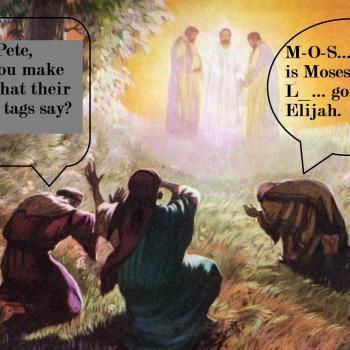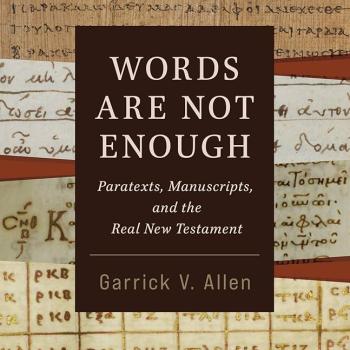Chapter 9 of Doherty’s book Jesus: Neither God Nor Man is a mere six pages in length. Into this small space is packed, first of all, a brief presentation of Platonism and Stoicism, focusing on transcendence and immanence and the use of concepts such as Demiurge, Logos and Wisdom to bridge the gap between the transcendent creator (in those systems featuring such) and creation. As is widely known, two key aspects of Wisdom in Jewish thought – pre-existence and a mediatorial role in creation – are also attributed to Christ in the New Testament – although the precise passages and their precise meaning are in fact topics of significant ongoing discussion among scholars.
Since none of the above is in dispute between mythicists and those who hold other viewpoints, let me turn attention to the heart of the matter as relates to the subject of mythicism. Doherty writes on p.94 that the “fallacy” of the widespread view that the aforementioned ideas are being applied to a historical Jesus is that “No identification with a human man is ever made, no writer gives us even a hint that an “application” to an historical Jesus is anywhere in their minds. As suggested earlier, scholars are guilty of reading into the text things they find hard to believe are not there.”
An uncharitable reading would be to say that Doherty is simply being dishonest. He continues to postpone discussion of all the hints that seem to point to a historical Jesus, but to say that they do not exist or are not at least hints is doing more than simply ignoring evidence. I know that Doherty will later in the book offer his own implausible attempt to eliminate any trace of a historical Jesus from these passages. But can one honestly and truthfully say that there is “no hint” in them? In addition to the passages we have mentioned so many times already which hint at Jesus’ humanity through their mention of his brother, his blood, his death by crucifixion, and his descent from David according to the flesh, consider the following as well:
Romans 9:4-5 For I could wish that I myself were cursed and cut off from Christ for the sake of my people, those of my own race, the Israelites. Theirs is the adoption as sons; theirs the divine glory, the covenants, the receiving of the law, the temple worship and the promises. Theirs are the patriarchs, and from them the Messiah according to the flesh.
Philippians 2:7-8 he made himself nothing by taking the form of a servant, being made in human likeness. And being found in appearance as a man, he humbled himself by becoming obedient to death— even death on a cross!
Hebrews 2:14-17 Since the children have flesh and blood, he too shared in their humanity so that by his death he might break the power of him who holds the power of death—that is, the devil…For this reason he had to be made like his brothers in every way, in order that he might become a merciful and faithful high priest in service to God, and that he might make atonement for the sins of the people.
No hint? Surely this is more than exaggeration. It will remain untrue even after Doherty offers his unconvincing attempt to explain these passages away later in the book. But to say there is “no hint” before even doing so is far worse, in my opinion. Doherty will actually note slightly later, on p.96, that Hebrews 5:7 says “During the days of his flesh, he offered up prayers and petitions with fervent cries and tears to the one who could save him from death, and he was heard because of his reverent submission.” To simply postpone once again discussion of the apparent reference to a human (fleshly) existence of Jesus, and merely state without discussion that the activities attributed to Jesus here are “derived from Scripture,” is simply unacceptable. For until some plausible mythicist interpretation of such apparent counter-evidence is offered, Doherty’s claim that there is “no hint” of a historical Jesus remains at best unpersuasive and at worst sounds like it is a lie.
What are we to make of this? Perhaps a more charitable reading would be to say that Doherty is blind to the fact that he is “reading out” of the text things he wishes not to find there, at least as much as the reverse is true in the case of just about everyone else reading the text, whom he accuses of reading things into the text. But many of us thinks that these hints are real and encourage us to take them seriously and posit that they mean what they appear to and at the bare minimum hint at a historical Jesus being in view.
A statement of Doherty’s on p.95 seems to me to get at the heart of the matter. He writes that “The saving acts which have occurred in the present time are not the events of Jesus’ death and resurrection. They are God’s granting of the rite of baptism and the bestowing of the Spirit…Christ, then, operates entirely on a spiritual level. He is a communicating and sacramental power now present in the world, impregnating the hearts and minds of believers. These are highly mystical ideas, and there is no justification for scholarship’s frequent attempt to see the Pauline phrase “in or through Christ” as a cryptic summary of Jesus’ life on earth.” I am not sure what scholars supposedly interpret the phrase “in Christ” in that way (when it is “through Christ” then it may in some instances be another matter). Certainly Albert Schweitzer offered a classic treatment of Paul’s “Christ mysticism” which E. P. Sanders revisited in his treatment of Paul and Palestinian Judaism. I doubt that many scholars or other interpreters would object much to what Doherty has written here. And yet even on his view, there is an earlier crucifixion and resurrection, which have salvific importance for Paul – they just happened in the celestial realm. And so the fact that Paul focuses so much attention on the present, on the spiritual experience of being “in Christ,” is compatible with both mainstream historians’ viewpoint and with mythicism, and is presumably an important part of the explanation for why the focus is less on past events in history or in the heavens than either side might expect given their understanding of Paul. Present spiritual experiences can often overshadow focus on past events – one need not seek demonstration for this only in ancient texts, since time spent in a Pentecostal congregation will demonstrate the same to be true.
Doherty concludes with some final consideration of the way early Christians viewed Christ as the one speaking in Scriptural passages. Since Doherty finds this phenomenon in 1 Clement, it is perhaps worth noting that this early Christian homily/letter says the following (1 Clement 32:2): “For of Jacob are all the priests and levites who minister unto the altar of God; of him is the Lord Jesus as concerning the flesh; of him are kings and rulers and governors in the line of Judah…” Since Doherty doesn’t discuss the text here, I will likewise leave it until later. But until he discusses it, please note for the time being that the author of 1 Clement doesn’t sound like a mythicist any more than Paul does, when one doesn’t ignore the hints the letter provides – and in some cases, what seem to be plain statements.
This chapter marks the end of part 3. I still do not see how anyone could conclude on the basis of what Doherty has written up until this point that mythicism is more likely to be correct than the existence of a historical Jesus. What do others think?












